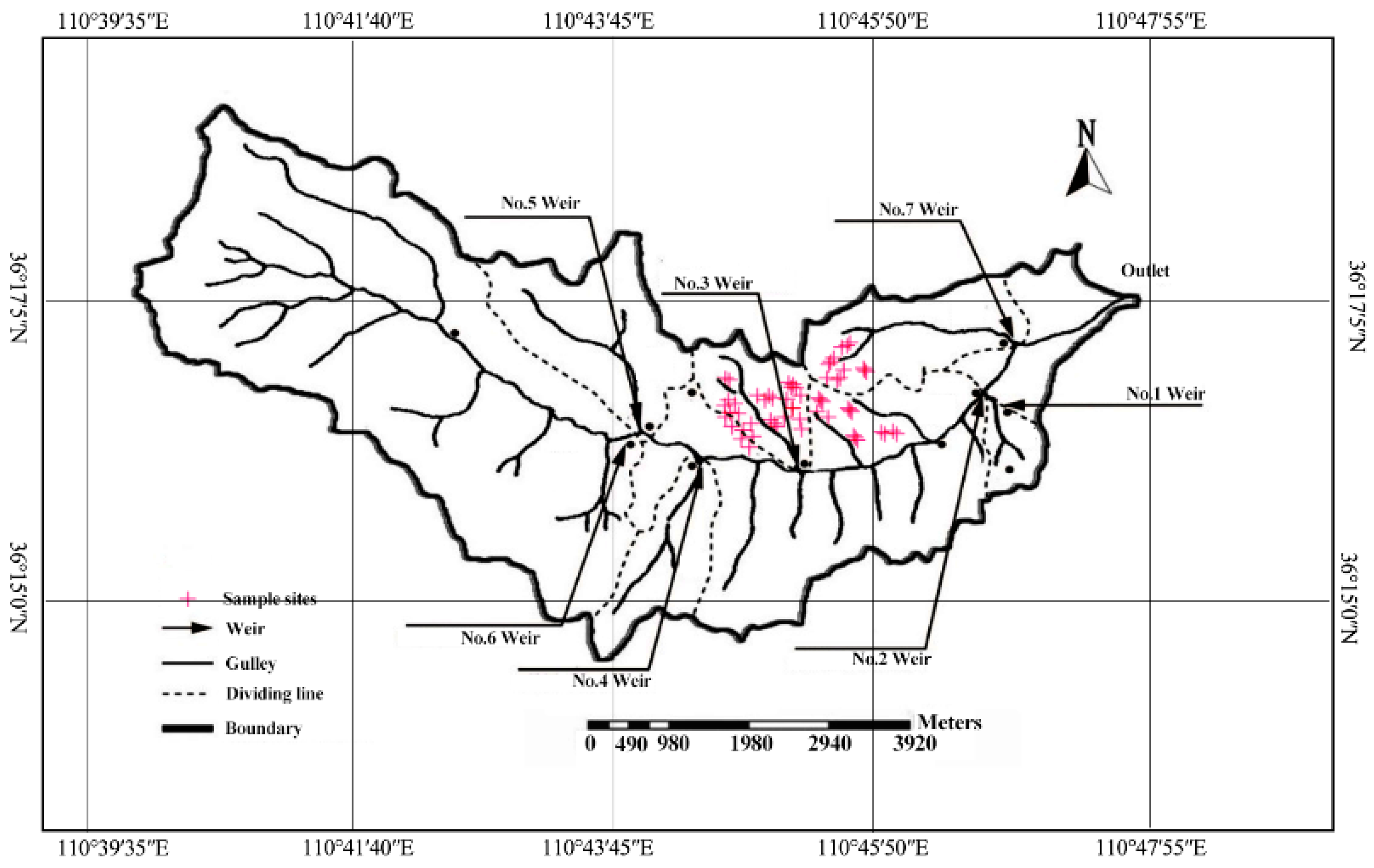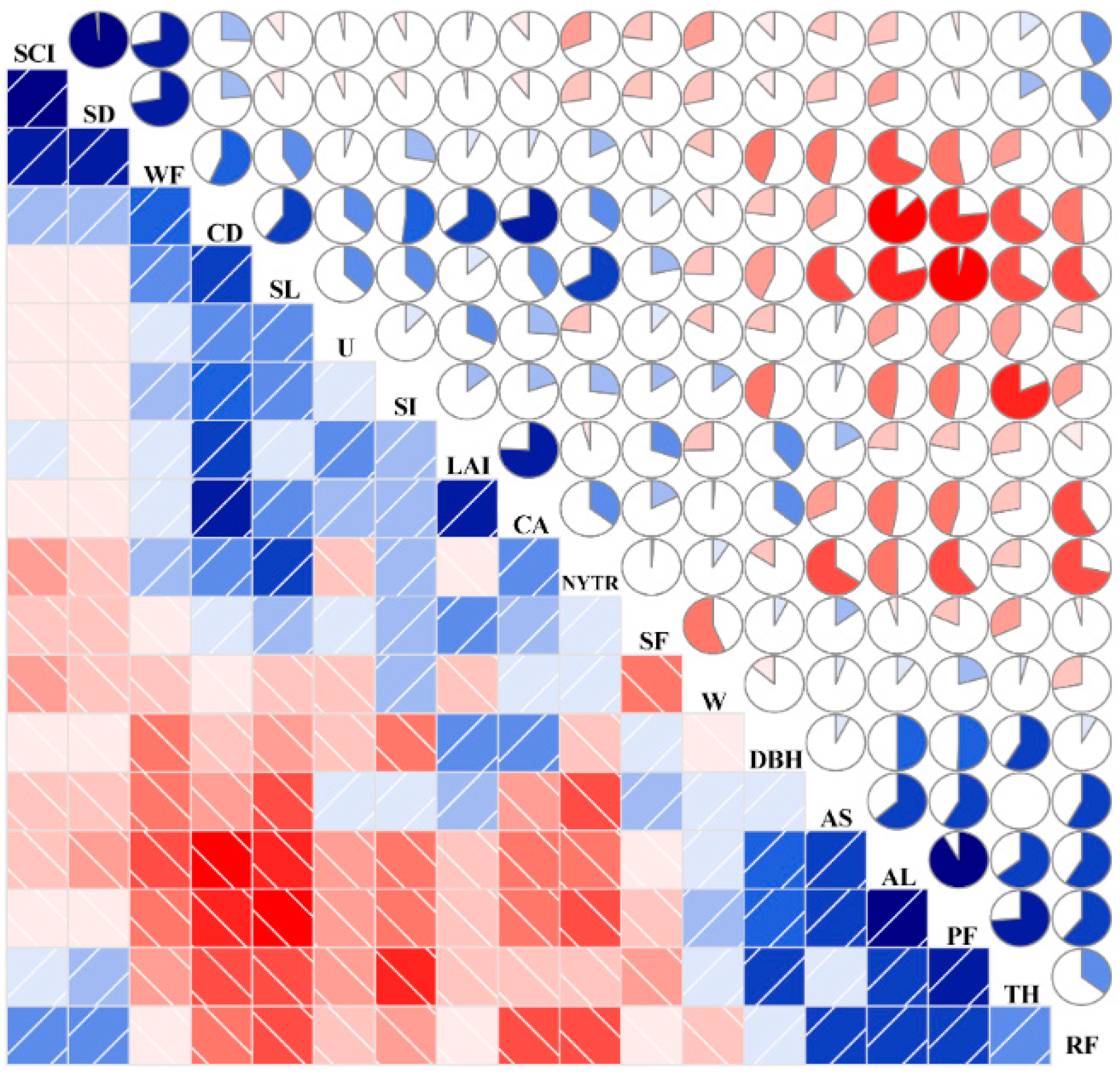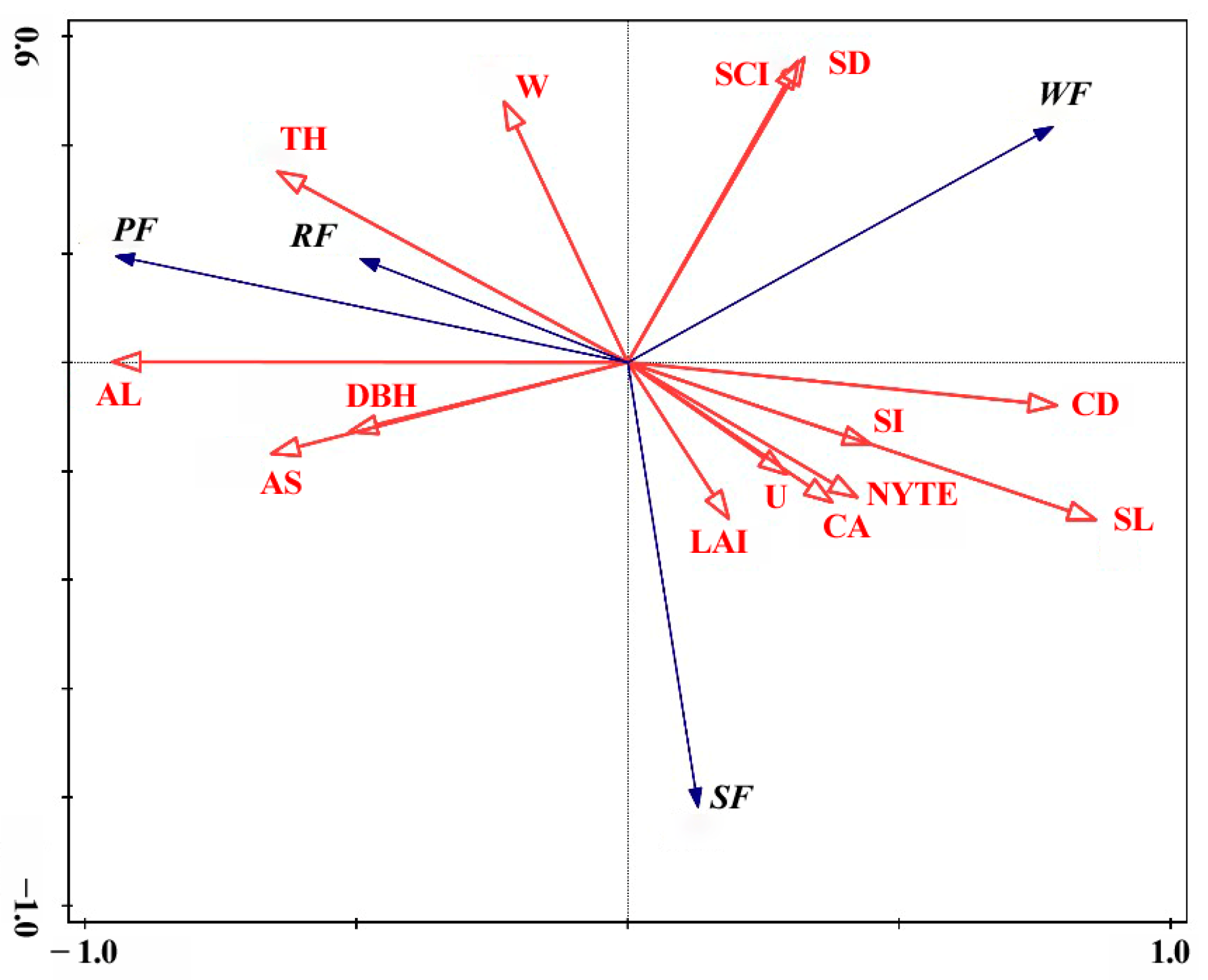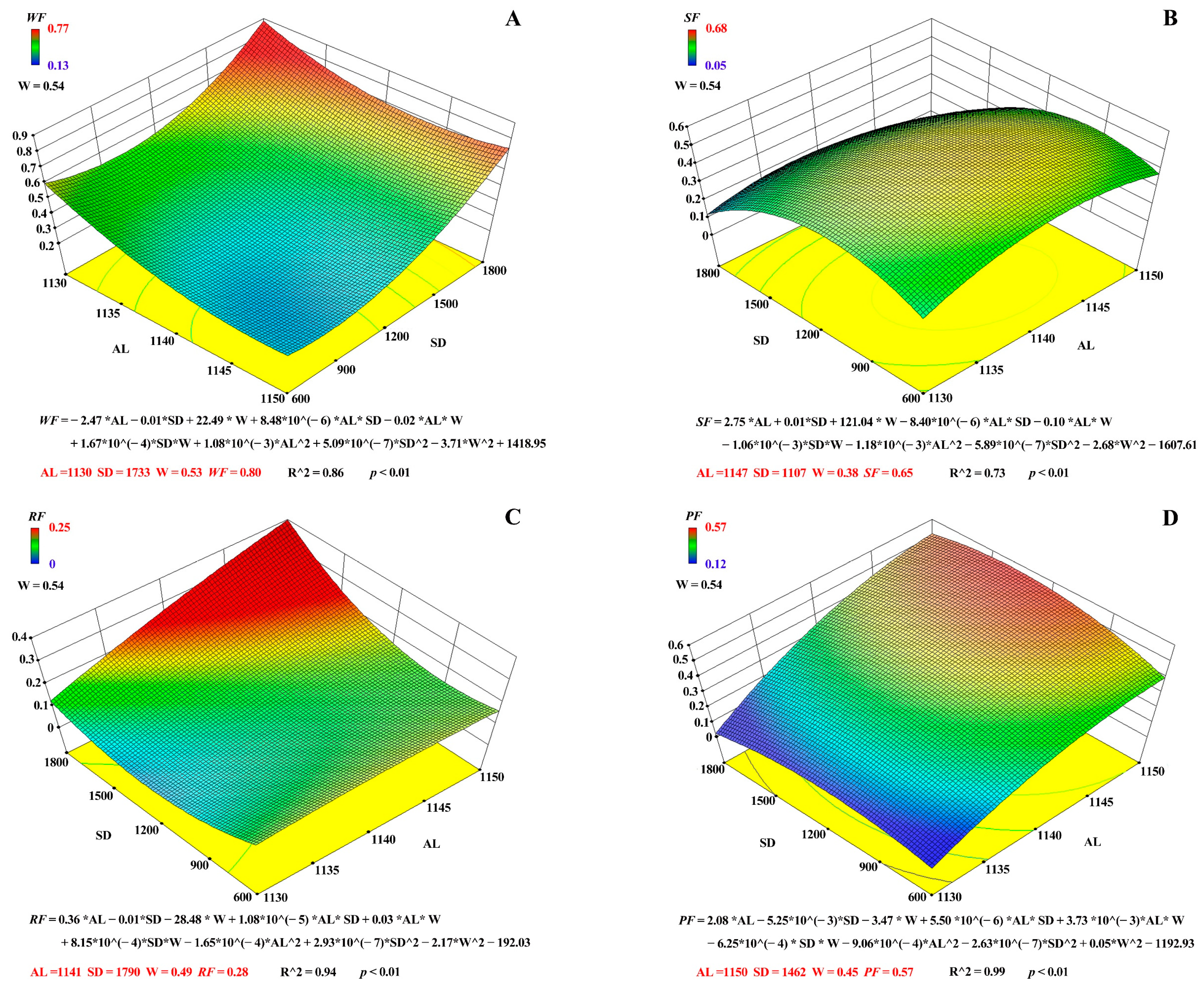The Strategy for Optimizing the Stand Structure of Pinus tabuliformis Carr. Forests to Enhance the Ecological Function on the Loess Plateau, China
Abstract
:1. Introduction
2. Materials and Methods
2.1. Site Description
2.2. Investigation of the Stand Structure and Topographical Factors and Functional Indices of Ecological Function
2.3. Statistical Analysis
2.4. Optimization of the Stand Structure of the Pinus tabuliformis Forest
3. Results
3.1. Evaluation of the Functional Indices of Ecological Function
3.2. Influence of the Stand Structure and Topographical Factors on the Functional Indices of Ecological Function
3.3. Establishment of Models for Stand Structure Optimization
4. Discussion
4.1. Evaluation of Ecological Functions of the Pinus tabuliformis Forest
4.2. Effects of the Altitude, Stand Density, and Uniform Angle Index on the Functional Indices of the Ecological Function of the Pinus tabuliformis Forest
4.3. Optimization Strategy of the Stand Structure of the Pinus tabuliformis Forest on the Loess Plateau
- (1)
- To determine the characteristics of the regulation target by understanding the stand structure and its ecological function characteristics through stand surveys on the altitude of the stand, stand density, uniform angle index of individual trees in the sample plot, and the average uniform angle index of the sample plot.
- (2)
- To determine the optimization target by quantifying and analyzing the ecological functions of the stand, selecting a certain functional index as the optimization target, and specifying the degree of improvement in the functional index.
- (3)
- To substitute the optimization target and altitude into the corresponding stand structure optimization model and determine the regulation direction and regulation range of the stand density, spatial structure (uniform angle index), and specific stand control measures. For the regulation of the stand density, it can be increased or decreased by replanting or interplanting. For the regulation of the uniform angle index, the main purpose is to balance the proportion of clustered, random, and uniformly distributed structural units in the spatial structure of the stand. If the uniform angle index of the stand needs to be increased, single trees with a small uniform angle index in the stand should be interplanted or transplanted; if the uniform angle index of the stand needs to be reduced, single trees with a large uniform angle index in the stand should be interplanted or transplanted, so that the uniform angle index of the stand meets the requirements. Furthermore, the regulation measures of the stand structure can be changed from a stand scale to a monoculture scale.
5. Conclusions
Author Contributions
Funding
Conflicts of Interest
Abbreviation
| Variable Abbreviations | Variable Name |
| SSTFs | Stand structure and topographical factors |
| EFFIs | Functional indices of ecological function |
| WF | Water-holding function |
| SF | Soil improvement function |
| RF | Function of reducing runoff and sediment yield on the slope |
| PF | Diversity function of the understory plants |
| SL | Slope |
| AS | Aspect |
| AL | Altitude |
| SD | Stand density |
| CD | Canopy density |
| NYTR | Number of young trees renewed |
| DBH | Diameter at breast height |
| TH | Tree height |
| CA | Crown area |
| LAI | Leaf area index |
| W | Uniform angle index |
| U | Neighborhood comparison |
| SCI | Stand competition index |
| SI | Stand layer index |
References
- Tang, K. Soil and Water Conservation in China; Chinese Science Press: Beijing, China, 2004. [Google Scholar]
- Nunez-Mir, G.C.; Iannone, B.V.; Curtis, K.; Fei, S. Evaluating the evolution of forest restoration research in a changing world: A “big literature” review. New For. 2015, 46, 669–682. [Google Scholar] [CrossRef]
- Song, X.; Peng, C.; Zhou, G.; Jiang, H.; Wang, W. Chinese Grain for Green Program led to highly increased soil organic carbon levels: A meta-analysis. Sci. Rep. 2014, 4, 4460. [Google Scholar] [CrossRef] [PubMed] [Green Version]
- Deng, L.; Yan, W.; Zhang, Y.; Shangguan, Z. Severe depletion of soil moisture following land-use changes for ecological restoration: Evidence from northern China. For. Ecol. Manag. 2016, 366, 1–10. [Google Scholar] [CrossRef]
- Feng, X.; Fu, B.; Piao, S.; Wang, S.; Ciais, P.; Zeng, Z.; Lü, Y.; Zeng, Y.; Li, Y.; Jiang, X.; et al. Revegetation in China’s Loess Plateau is approaching sustainable water resource limits. Nat. Clim. Chang. 2016, 6, 1019–1022. [Google Scholar] [CrossRef]
- Yang, K.; Lu, C. Evaluation of land-use change effects on runoff and soil erosion of a hilly basin—The Yanhe River in the Chinese Loess Plateau. Land Degrad. Dev. 2018, 29, 1211–1221. [Google Scholar] [CrossRef]
- Xin, Z.B.; Yu, B.F.; Han, Y.G. Spatiotemporal variations in annual sediment yield from the middle yellow river, China, 1950–2010. J. Hydrol. Eng. 2015, 20, 04014090. [Google Scholar] [CrossRef]
- Cao, S.; Zhang, J. Political risks arising from the impacts of large-scale afforestation on water resources of the Tibetan Plateau. Gondwana Res. 2015, 28, 898–903. [Google Scholar] [CrossRef]
- Cao, S.; Zhang, J.; Chen, L.; Zhao, T. Ecosystem water imbalances created during ecological restoration by afforestation in China, and lessons for other developing countries. J. Environ. Manag. 2016, 183, 843–849. [Google Scholar] [CrossRef] [PubMed]
- Zhang, J.; Zhao, T.; Jiang, C.; Cao, S. Opportunity cost of water allocation to afforestation rather than conservation of natural vegetation in China. Land Use Policy 2016, 50, 67–73. [Google Scholar] [CrossRef]
- Jia, X.; Shao, M.; Zhang, C.; Zhao, C. Regional temporal persistence of dried soil layer along south–north transect of the Loess Plateau, China. J. Hydrol. 2015, 528, 152–160. [Google Scholar] [CrossRef]
- Jia, X.; Shao, M.; Zhu, Y.; Luo, Y. Soil moisture decline due to afforestation across the Loess Plateau, China. J. Hydrol. 2017, 546, 113–122. [Google Scholar] [CrossRef]
- Wang, Y.H.; Xiong, W.; Yu, P.T.; Shen, Z.X.; Guo, M.C.; Guan, W.; Ma, C.M.; Ye, B.; Guo, H. Study on the evapotranspiration of forest and vegetation in dryland. Sci. Soil Water Conserv. 2006, 4, 19–25. [Google Scholar]
- Wang, N.; Bi, H.; Cui, Y.; Zhao, D.; Hou, G.; Yun, H.; Liu, Z.; Lan, D.; Jin, C. Optimization of stand structure in Robinia pseudoacacia Linn. based on soil and water conservation improvement function. Ecol. Indic. 2022, 136, 108671. [Google Scholar] [CrossRef]
- Lindenmayer, D.B.; Margules, C.R.; Botkin, D.B. Indicators of Biodiversity for Ecologically Sustainable Forest Management. Conserv. Biol. 2000, 14, 941–950. [Google Scholar] [CrossRef]
- Ishii, H.T.; Tanabe, S.; Hiura, T. Exploring the relationships among canopy structure, stand productivity, and biodiversity of temperature forest ecosystems. For. Sci. 2004, 50, 342–355. [Google Scholar] [CrossRef]
- Ribe, R.G. In-stand scenic beauty of variable retention harvests and mature forests in the U.S. Pacific Northwest: The effects of basal area, density, retention pattern and down wood. J. Environ. Manag. 2009, 91, 245–260. [Google Scholar] [CrossRef] [PubMed]
- Ali, A. Forest stand structure and functioning: Current knowledge and future challenges. Ecol. Indic. 2018, 98, 665–677. [Google Scholar] [CrossRef]
- Zhang, J.J.; He, W.; Na, L. Study on appropriate density of Pinus tabulaeformis and Robinia Pseudocacia for soil and water con-servation forests in Loess area. Sci. Soil Water Conserv. 2007, 5, 55–59. [Google Scholar]
- Hacisalihoglu, S. Semi-Arid Plantation by Anatolian Black Pine and Its Effects on Soil Erosion and Soil Properties. Turk. J. Agric. Food Sci. Technol. 2018, 6, 500–507. [Google Scholar] [CrossRef] [Green Version]
- Lucas-Borja, M.; Hedo, J.; Cerdá, A.; Candel-Pérez, D.; Viñegla, B. Unravelling the importance of forest age stand and forest structure driving microbiological soil properties, enzymatic activities and soil nutrients content in Mediterranean Spanish black pine(Pinus nigra Ar. ssp. salzmannii) Forest. Sci. Total Environ. 2016, 562, 145–154. [Google Scholar] [CrossRef]
- Zhu, D.J.; Wen, Z.M.; Zhang, J.; Tao, Y.; Zeng, H.W.; Tang, Y. Effects of alien species Robinia pseudoacacia on plant community functional structure in hilly-gully region of Loess Plateau, China. J. Appl. Ecol. 2018, 29, 459–466. [Google Scholar]
- Zhao, Y.; Li, M.; Deng, J.; Wang, B. Afforestation affects soil seed banks by altering soil properties and understory plants on the eastern Loess Plateau, China. Ecol. Indic. 2021, 126, 107670. [Google Scholar] [CrossRef]
- Hui, G.Y.; Klaus, V.G.; Hu, Y.B.; Xu, H. Structure-Based Forest Management; China Forestry Publishing House: Beijing, China, 2007; pp. 32–60. [Google Scholar]
- Xu, Z. Study on Ecological Function Evaluation and Biodiversity of Typical Forest Stands in Jinxi of the Loess Plateau. Master’s Thesis, Beijing Forestry University, Beijing, China, 2014. [Google Scholar]
- Mason, N.W.H.; Mouillot, D.; Lee, W.G.; Wilson, J.B. Functional richness, functional evenness and functional divergence: The primary components of functional diversity. Oikos 2005, 111, 112–118. [Google Scholar] [CrossRef]
- Sun, L.; Chang, X.; Yu, X.; Jia, G.; Chen, L.; Liu, Z.; Zhu, X. Precipitation and soil water thresholds associated with drought-induced mortality of farmland shelter forests in a semi-arid area. Agric. Ecosyst. Environ. 2019, 284, 106595. [Google Scholar] [CrossRef]
- Shi, W.-Y.; Du, S.; Morina, J.C.; Guan, J.-H.; Wang, K.-B.; Ma, M.-G.; Yamanaka, N.; Tateno, R. Physical and biogeochemical controls on soil respiration along a topographical gradient in a semiarid forest. Agric. For. Meteorol. 2017, 247, 1–11. [Google Scholar] [CrossRef]
- Johnson, D.W.; Curtis, P.S. Effects of forest management on soil C and N storage: Meta analysis. For. Ecol. Manag. 2001, 140, 227–238. [Google Scholar] [CrossRef]
- Wei, X.; Bi, H.; Liang, W.; Hou, G.; Kong, L.; Zhou, Q. Relationship between Soil Characteristics and Stand Structure of Robinia pseudoacacia L. and Pinus tabulaeformis Carr. Mixed Plantations in the Caijiachuan Watershed: An Application of Structural Equation Modeling. Forests 2018, 9, 124. [Google Scholar] [CrossRef] [Green Version]
- Saura-Mas, S.; Estiarte, M.; Peñuelas, J.; Lloret, F. Effects of climate change on leaf litter decomposition across post-fire plant regenerative groups. Environ. Exp. Bot. 2011, 77, 274–282. [Google Scholar] [CrossRef]
- Guendehou, G.H.S.; Liski, J.; Tuomi, M.; Moudachirou, M.; Sinsin, B.; Mäkipää, R. Test of validity of a dynamic soil carbon model using data from leaf litter decomposition in a West African tropical forest. Geosci. Model Dev. Discuss. 2013, 6, 3003–3032. [Google Scholar] [CrossRef]
- He, X.; Lin, Y.; Han, G.; Ma, T. Litterfall interception by understorey vegetation delayed litter decomposition in Cinnamomum camphora plantation forest. Plant Soil 2013, 372, 207–219. [Google Scholar] [CrossRef]
- Diemont, S.A.; Bohn, J.L.; Rayome, D.D.; Kelsen, S.J.; Cheng, K. Comparisons of Mayan forest management, restoration, and conservation. For. Ecol. Manag. 2011, 261, 1696–1705. [Google Scholar] [CrossRef]
- Chen, Y.; Wang, K.; Lin, Y.; Shi, W.; Song, Y.; He, X. Balancing green and grain trade. Nat. Geosci. 2015, 8, 739–741. [Google Scholar] [CrossRef]
- Mo, K.; Cong, Z.; Lei, H. Optimal vegetation cover in the Horqin Sands, China. Ecohydrology 2016, 9, 700–711. [Google Scholar] [CrossRef]
- Wang, S.; Fu, B.; Chen, H.; Liu, Y. Regional development boundary of China’s Loess Plateau: Water limit and land shortage. Land Use Policy 2018, 74, 130–136. [Google Scholar] [CrossRef]
- Ishii, R.; Higashi, M. Tree coexistence on a slope: An adaptive significance of trunk inclination. Proc. R. Soc. B Boil. Sci. 1997, 264, 133–139. [Google Scholar] [CrossRef] [Green Version]
- Anderson, K.E.; Furley, P.A. An assessment of the relationship between the surface properties of chalk soils and slope form using principal components analysis. J. Soil Sci. 1975, 26, 130–143. [Google Scholar] [CrossRef]
- Wang, J.Y.; Wang, Y.L.; Jin, B.W. Studies on regulating function of forest hydrology and microclimate in arid and semi—Arid area of west China. Sci. Silvae Sin. 2001, 37, 120–125. [Google Scholar]
- Wood, T.; Lawrence, D.; Clark, D.A. Determinants of Leaf Litter Nutrient Cycling in a Tropical Rain Forest: Soil Fertility Versus Topography. Ecosystems 2006, 9, 700–710. [Google Scholar] [CrossRef]
- Griffiths, R.; Madritch, M.; Swanson, A. The effects of topography on forest soil characteristics in the Oregon Cascade Mountains (USA): Implications for the effects of climate change on soil properties. For. Ecol. Manag. 2009, 257, 1–7. [Google Scholar] [CrossRef]
- Song, X.; Wang, G.; Ran, F.; Chang, R.; Song, C.; Xiao, Y. Effects of topography and fire on soil CO2 and CH4 flux in boreal forest underlain by permafrost in northeast China. Ecol. Eng. 2017, 106, 35–43. [Google Scholar] [CrossRef]
- Garcia-Pausas, J.; Casals, P.; Camarero, L.; Huguet, C.; Sebastià, M.T.; Thompson, R.; Romanyà, J. Soil organic carbon storage in mountain grasslands of the Pyrenees: Effects of climate and topography. Biodegradation 2007, 82, 279–289. [Google Scholar] [CrossRef]
- Pennock, D.J. Precision conservation for co-management of carbon and nitrogen on the Canadian prairies. J. Soil Water Conserv. 2005, 60, 305–306. [Google Scholar]
- Wang, M.; Zhang, W.H. Growth and Species Diversity of Pinus tabulaeformis Artificial Forest on different Slope Aspects. Acta Bot. Boreali Occident. Sin. 2009, 29, 1678–1683. [Google Scholar]
- Sizemskaya, M.L.; Jiao, J.Y.; Wang, N.; Sapanov, M.K.; Wu, Q.X.; Jia, Y.F.; Kolesnikov, A.V.; Liu, G.B.; Sapanov, P.M. Specificity of afforestation under conditions of moisture deficit in south of Russian plain and the Loess Plateau of China. Res. Soil Water Conserv. 2009, 16, 73–77. [Google Scholar] [CrossRef]
- Nan, G.W.; Wang, N.; Jiao, L.; Zhu, Y.M.; Sun, H. A new exploration for accurately quantifying the effect of afforestation on soil moisture: A case study of artificial Robinia pseudoacacia in the Loess Plateau (China). For. Ecol. Manag. 2019, 433, 459–466. [Google Scholar] [CrossRef]
- Hou, G.; Bi, H.; Wei, X.; Wang, N.; Cui, Y.; Zhao, D.; Ma, X.; Wang, S. Optimal configuration of stand structures in a low-efficiency Robinia pseudoacacia forest based on a comprehensive index of soil and water conservation ecological benefits. Ecol. Indic. 2020, 114, 106308. [Google Scholar] [CrossRef]
- Deng, L.; Zhu, G.-Y.; Tang, Z.-S.; Shangguan, Z.-P. Global patterns of the effects of land-use changes on soil carbon stocks. Glob. Ecol. Conserv. 2016, 5, 127–138. [Google Scholar] [CrossRef] [Green Version]
- Li, Y.; Hui, G.; Zhao, Z.; Hu, Y. The bivariate distribution characteristics of spatial structure in natural Korean pine broad-leaved forest. J. Veg. Sci. 2012, 23, 1180–1190. [Google Scholar] [CrossRef]
- Wei, W.; Chen, L.; Fu, B.; Chen, J. Water erosion response to rainfall and land use in different drought-level years in a loess hilly area of China. Catena 2010, 81, 24–31. [Google Scholar] [CrossRef]
- Fu, B.; Liu, Y.; Lü, Y.; He, C.; Zeng, Y.; Wu, B. Assessing the soil erosion control service of ecosystems change in the Loess Plateau of China. Ecol. Complex. 2011, 8, 284–293. [Google Scholar] [CrossRef]
- Jia, X.X.; Shao, M.A.; Yu, D.X.; Zhang, Y.; Andrew, B. Spatial variations in soilwater carrying capacity of three typical reveg-etation species on the Loess Plateau, China. Agric. Ecosyst. Environ. 2019, 273, 25–35. [Google Scholar] [CrossRef] [Green Version]
- Jian, S.; Zhao, C.; Fang, S.; Yu, K. Effects of different vegetation restoration on soil water storage and water balance in the Chinese Loess Plateau. Agric. For. Meteorol. 2015, 206, 85–96. [Google Scholar] [CrossRef]
- Sun, B.; Yang, G.T.; Li, H.; Ma, R.P. The age structure of population and community succession of Betula platyphylla Suk. J. Northeast. For. Univ. 1994, 3, 43–48. [Google Scholar]
- Zhang, J.C.; Chen, L.; Guo, Q.S.; Nie, D.P.; Bai, X.L.; Jiang, Y.X. Research on the change trend of dominant tree population distribution patterns during development process of climax forest communities. Chin. J. Plant Ecol. 1999, 23, 256–268. [Google Scholar]
- Zhang, X.; Zhao, X.; Kang, F.F.; Wang, J.W.; He, Z.B.; Ma, Q.; Li, W.M.; Yao, Z. Spatial pattern of the trees in a natural Pinus tabulaeformis forest in Taiyue Mountain. Acta Ecol. Sin. 2010, 30, 4821–4827. [Google Scholar]
- Yi, L.T.; Han, H.R.; Cheng, X.Q.; Kang, F.F.; Zhang, Z.J. Spatial distribution patterns of Quercus liaotungensis population in Lingkong Mountains. Acta Ecol. Sin. 2008, 28, 3254–3261. [Google Scholar]





| Category | Grade I Index | Grade II Index | Max | Min | Mean | VC |
|---|---|---|---|---|---|---|
| SSTFs | Topographic factors | Slope (°) | 35 | 26 | 29.75 | 0.112 |
| Aspect | 4 | 1 | 2.50 | 0.368 | ||
| Altitude (m) | 1150 | 1130 | 1143 | 0.007 | ||
| Stand structure factors | Stand density (plant·hm−2) | 1800 | 600 | 1106 | 0.326 | |
| Canopy density | 0.87 | 0.54 | 0.70 | 0.139 | ||
| Number of young trees renewed (n) | 7.00 | 2.00 | 4.19 | 0.350 | ||
| Diameter at breast height (cm) | 14.55 | 11.91 | 13.25 | 0.068 | ||
| Tree height (m) | 8.69 | 5.78 | 7.06 | 0.121 | ||
| Crown area (m2) | 16.74 | 7.04 | 10.55 | 0.274 | ||
| Leaf area index | 3.04 | 1.25 | 1.97 | 0.259 | ||
| Uniform angle index | 0.70 | 0.38 | 0.52 | 0.187 | ||
| Neighborhood comparison | 0.63 | 0.25 | 0.52 | 0.174 | ||
| Stand competition index | 2.23 | 1.17 | 1.57 | 0.193 | ||
| Stand layer index | 0.50 | 0.00 | 0.19 | 0.866 | ||
| EFFIs | WF | Canopy interception rate (%) | 20.40 | 8.70 | 15.28 | 0.216 |
| WRRU (%) | 7.32 | 2.62 | 3.34 | 0.331 | ||
| WRRS (%) | 5.40 | 2.73 | 3.72 | 0.154 | ||
| Soil infiltration rate (mm/h) | 277.05 | 219.30 | 236.16 | 0.10 | ||
| Soil moisture content (%) | 0.17 | 0.06 | 0.11 | 0.256 | ||
| Maximum water holding capacity (%) | 0.61 | 0.26 | 0.47 | 0.172 | ||
| SF | Total nitrogen (g/kg) | 1.76 | 0.18 | 0.71 | 0.720 | |
| Ammonia-nitrogen (mg/kg) | 34.42 | 17.72 | 25.41 | 0.196 | ||
| Nitrate-nitrogen (mg/kg) | 13.33 | 1.56 | 6.67 | 0.422 | ||
| Total phosphorus (g/kg) | 1.82 | 0.47 | 0.67 | 0.495 | ||
| Available phosphorus (mg/kg) | 55.66 | 25.52 | 36.37 | 0.212 | ||
| Soil organic matter (g/kg) | 18.97 | 3.49 | 9.26 | 0.417 | ||
| RF | Average runoff yield (mm) | 78.02 | 65.42 | 72.52 | 0.041 | |
| Average sediment yield (t·km−2) | 604 | 361 | 462.94 | 0.184 | ||
| PF | Shannon diversity index of the shrubs | 1.61 | 0.49 | 1.17 | 0.373 | |
| Simpson diversity index of the shrubs | 0.75 | 0.49 | 0.67 | 0.158 | ||
| Pielou uniformity index of the shrubs | 0.83 | 0.68 | 0.76 | 0.089 | ||
| Shannon diversity index of the herbs | 1.91 | 1.53 | 1.75 | 0.078 | ||
| Simpson diversity index of the herbs | 0.80 | 0.73 | 0.77 | 0.038 | ||
| Pielou uniformity index of the herbs | 0.86 | 0.80 | 0.84 | 0.029 |
| Grade I Index | Weight | Grade II Index | Weight |
|---|---|---|---|
| WF | 0.319 | Canopy interception rate | 0.023 |
| WRRU | 0.104 | ||
| WRRS | 0.025 | ||
| Soil infiltration rate | 0.026 | ||
| Soil moisture content | 0.127 | ||
| Maximum water holding capacity | 0.015 | ||
| SF | 0.323 | Total nitrogen | 0.064 |
| Ammonia-nitrogen | 0.035 | ||
| Nitrate-nitrogen | 0.026 | ||
| Total phosphorus | 0.126 | ||
| Available phosphorus | 0.038 | ||
| Soil organic matter | 0.034 | ||
| RF | 0.062 | Average runoff yield | 0.026 |
| Average sediment yield | 0.036 | ||
| PF | 0.296 | Shannon diversity index of the shrubs | 0.046 |
| Simpson diversity index of the shrubs | 0.042 | ||
| Pielou uniformity index of the shrubs | 0.065 | ||
| Shannon diversity index of the herbs | 0.045 | ||
| Simpson diversity index of the herbs | 0.05 | ||
| Pielou uniformity index of the herbs | 0.048 |
| SSTFs | Explanation % | Contribution % | pseudo-F | p |
|---|---|---|---|---|
| Altitude | 44.5 | 48.1 | 11.2 | 0.002 ** |
| Stand Density | 15.8 | 17.0 | 5.2 | 0.006 ** |
| Uniform Angle | 15.0 | 16.2 | 7.3 | 0.004 ** |
| Slope | 4.4 | 4.7 | 2.4 | 0.076 |
| Tree Height | 2.7 | 2.9 | 1.5 | 0.246 |
| Stand Competition Index | 1.3 | 1.4 | 0.7 | 0.526 |
| Crown Area | 0.6 | 0.7 | 0.3 | 0.734 |
| Canopy Density | 1.7 | 1.8 | 0.8 | 0.444 |
| Aspect | 1.2 | 1.3 | 0.5 | 0.562 |
| Diameter at Breast Height | 0.7 | 0.8 | 0.3 | 0.644 |
| Number of Young Trees Renewed | 0.7 | 0.8 | 0.3 | 0.728 |
| Leaf Area Index | 1.1 | 1.2 | 0.3 | 0.694 |
| Stand Layer Index | 2.2 | 2.3 | 0.5 | 0.576 |
| Neighborhood Comparison | 0.7 | 0.8 | <0.1 | 0.844 |
Publisher’s Note: MDPI stays neutral with regard to jurisdictional claims in published maps and institutional affiliations. |
© 2022 by the authors. Licensee MDPI, Basel, Switzerland. This article is an open access article distributed under the terms and conditions of the Creative Commons Attribution (CC BY) license (https://creativecommons.org/licenses/by/4.0/).
Share and Cite
Wang, N.; Bi, H.; Peng, R.; Zhao, D.; Yun, H.; Liu, Z.; Lan, D.; Jin, C. The Strategy for Optimizing the Stand Structure of Pinus tabuliformis Carr. Forests to Enhance the Ecological Function on the Loess Plateau, China. Forests 2022, 13, 1217. https://doi.org/10.3390/f13081217
Wang N, Bi H, Peng R, Zhao D, Yun H, Liu Z, Lan D, Jin C. The Strategy for Optimizing the Stand Structure of Pinus tabuliformis Carr. Forests to Enhance the Ecological Function on the Loess Plateau, China. Forests. 2022; 13(8):1217. https://doi.org/10.3390/f13081217
Chicago/Turabian StyleWang, Ning, Huaxing Bi, Ruidong Peng, Danyang Zhao, Huiya Yun, Zehui Liu, Daoyun Lan, and Chuan Jin. 2022. "The Strategy for Optimizing the Stand Structure of Pinus tabuliformis Carr. Forests to Enhance the Ecological Function on the Loess Plateau, China" Forests 13, no. 8: 1217. https://doi.org/10.3390/f13081217
APA StyleWang, N., Bi, H., Peng, R., Zhao, D., Yun, H., Liu, Z., Lan, D., & Jin, C. (2022). The Strategy for Optimizing the Stand Structure of Pinus tabuliformis Carr. Forests to Enhance the Ecological Function on the Loess Plateau, China. Forests, 13(8), 1217. https://doi.org/10.3390/f13081217






